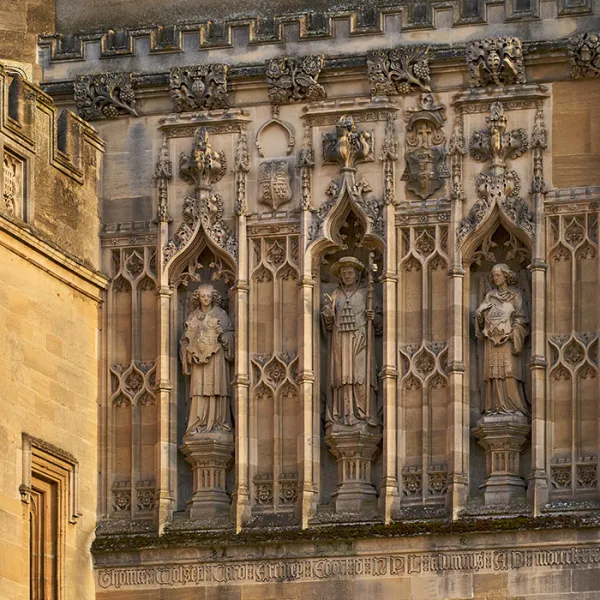Although Christ Church attracts many thousands of visitors each year, it remains a working institution with a twofold purpose: the pursuit of learning and Cathedral worship.
Meadow Quad
The Meadow Building, through which visitors enter and exit, was built expressly for undergraduates in the 19th century – a time when Christ Church, like the rest of the University, was undergoing a series of important reforms to strengthen the emphasis on undergraduate education.
The Meadow Building is in the Venetian Gothic style, popularised in the Victorian period through the writings of one Christ Church alumnus, John Ruskin. But the building was designed by an Irish architect, TN Deane, well known in Dublin for his work on the National Museum and Library.
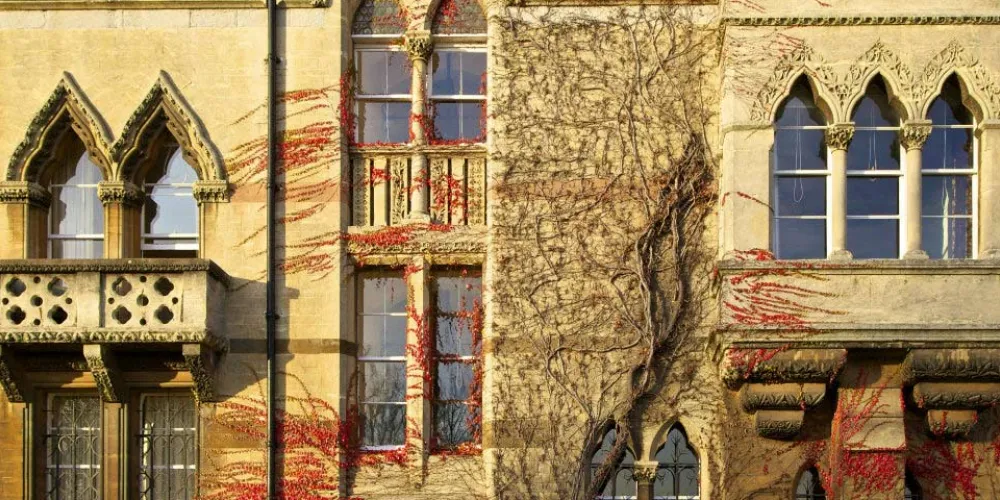

Hall Staircase
Bodley Tower (named after the architect GF Bodley, rather than Thomas Bodley of Bodleian Library fame), houses the staircase to Hall.
Following Wolsey’s fall in 1529, most of the college was still under construction and it was only later that the staircase you now see was installed (the present incarnation dates from 1805). The dramatic fanned vaulting of the ceiling was installed just before the civil war, in 1638; the style is medieval but it was made possible by the new techniques of the 17th century.
The elegant staircase may be familiar, having been used in a number of film and television projects including Lewis and Harry Potter.
The Great Hall
Completed alongside the kitchens in the 1520s, the Hall has been in almost constant use since the 16th century. Until the 1870s this was the largest Hall in Oxford. It displays the Renaissance magnificence of Cardinal College and suggests the scale it might have reached had it not been for Wolsey’s fall.
The walls are adorned with a number of portraits, each celebrating famous members of the college from WH Auden to Professor Judith Pallot. At the far end, the founder of Christ Church, Henry VIII, is portrayed. The table at the far end of the Hall is known as High Table and it is here that senior members of the college dine.
Light enters the Hall through a series of stained glass windows celebrating Christ Church’s vibrant heritage. One window celebrates the fantastical work of Charles Dodgson – or Lewis Carroll – and the inspiration for his works, Alice Liddell, who was the daughter of Dean Liddell.


Tom Quad
Passing out of the Hall you emerge into the Great Quadrangle, the heart of Christ Church, often referred to informally as ‘Tom Quad’ after the bell in Wren’s tower.
The quad is the largest in Oxford, measuring 264 feet by 261, and it would have been cloistered were it not for Wolsey’s demise in 1530 - the pillars and arches on which the cloister would have rested are still visible on the outside of the buildings.
Christopher Wren was commissioned to design a clock tower to crown the St. Aldate’s gatehouse. Plans were approved in late spring of 1681, Christopher Kempster was appointed as builder and work were completed by Michaelmas of 1682. Great Tom rang from the new tower for the first time on 29 May 1684.
Great Tom
Tom Tower and its great bell are to Christ Church and to Oxford, what Elizabeth Tower and Big Ben are to London. For over three hundred years, Great Tom, the bell residing in the belfry of Tom Tower, has provided the background noise to life in Oxford.
Great Tom chimes 101 times at 9.05pm, which corresponds with 9.00pm Oxford time - though in 1852 Greenwich Mean Time was formally adopted nationwide, Christ Church steadfastly retained ‘Oxford’ time, five minutes behind GMT. It also signals the curfew for students to return to college - this still continues even though students are no longer bound by a curfew.
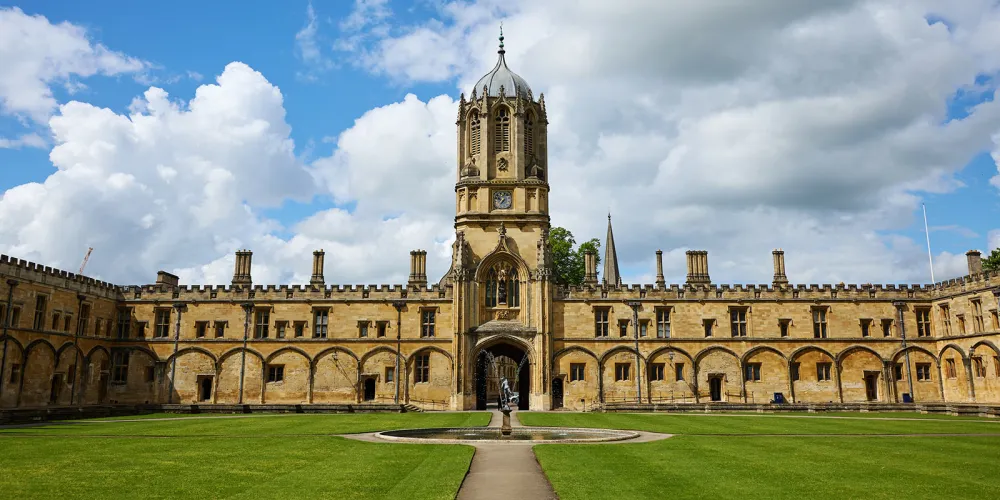

Mercury
Although apparently ornamental, the pond and fountain at the centre of Tom Quad, now adorned by a statue of Mercury, was not designed as a decorative feature. Its first role was as a ready source of water in the event of a fire – and with good reason: in the mid-17th century, a disastrous fire near the cloisters had destroyed the house of a Canon.
The statue at the centre of the reservoir has been through several incarnations. Originally there was a lead-gilt globe with a fountain in the form of a serpent. The globe and serpent were removed in 1695, and a statue of Mercury replaced it. Finally, in 1928, a lead copy of Giovanni da Bologna’s statue of Mercury was given to the college by a benefactor and placed on a pedestal by the famous architect Sir Edward Lutyens. It remains there to this day.
Please note that visitors will be able to see the fountain from the upper walkway (visitor route) in Tom Quad only. There is no visitor access to the centre of Tom Quad.
Peckwater Quad
The New Library provides a striking contrast with the rest of the Peckwater area. The Library’s vast Corinthian columns offset the elegance of the Peckwater buildings. Peckwater is one of the earliest pure Palladian buildings in England, a style derived and inspired by the Venetian architect Andrea Palladio and strongly based on the symmetry, perspective and values of the formal temple architecture of the ancient Greeks and Romans.
It was built at the start of the 18th century to accommodate undergraduates, the function it retains today. The design of the building is by Henry Aldrich, Christ Church’s most ‘Renaissance’ Dean. Aldrich was a clergyman, architect, composer and classical scholar – a man of many talents indeed.
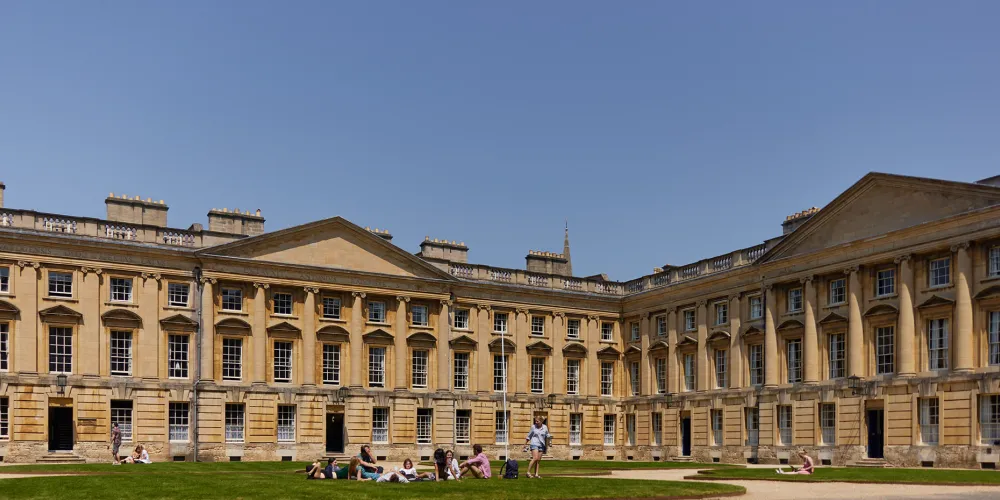
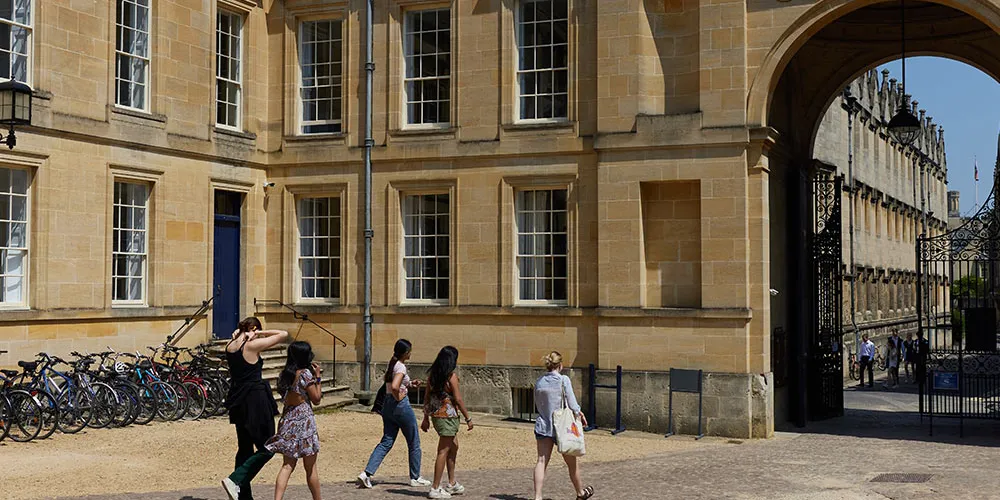
Canterbury Quad
Built on the site of the medieval Canterbury College, after which the quad takes its name, the buildings here originally housed undergraduates at Christ Church. Today, rooms in Canterbury are mainly used by university tutors as the location for tutorials.
Since the 1960s, Canterbury has also provided access to Christ Church Picture Gallery. Designed by the architects Powell and Moya, and opened in 1968, the gallery houses Christ Church’s remarkable collection of artistic treasures, which includes drawings by Da Vinci, Michelangelo and Raphael.
The Cathedral
The college was founded on the site of the former monastery of St Frideswide’s. Most of the Cathedral was built at the end of the 12th century as the priory church for the Augustinian Canons who resided there. The church has undergone considerable alteration since then; most significantly, the interior was redesigned in the 19th century by the gothic revivalist architect, Sir George Gilbert Scott.
Christ Church was founded amidst the religious changes of Henry VIII’s reign and while Henry was re-establishing the college as Christ Church in 1546, he was also carving out a new diocese in Oxford. Previously, he had made the church of Osney Abbey Oxford’s cathedral, but in releasing funds for Christ Church, he decided to save expense by turning its chapel to a new purpose – as a cathedral. The relationship between the two sides of Christ Church is thus unique within England.
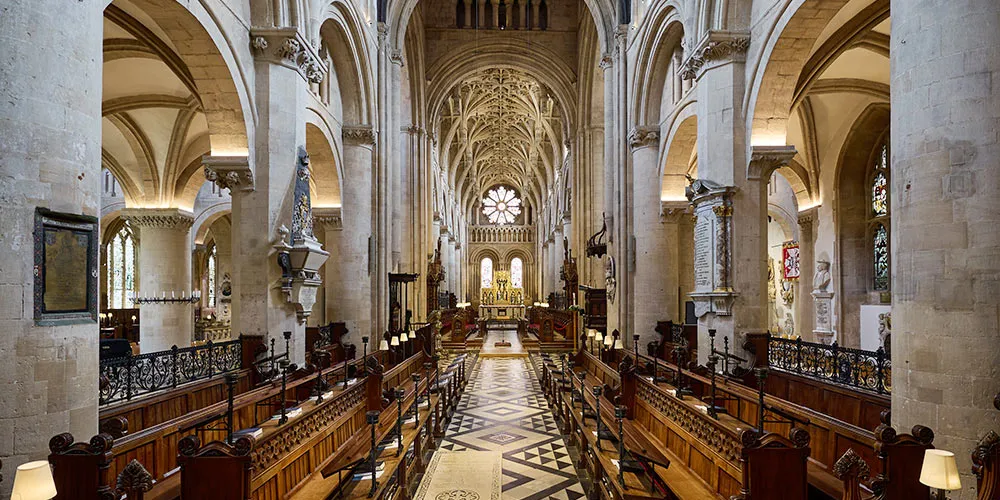
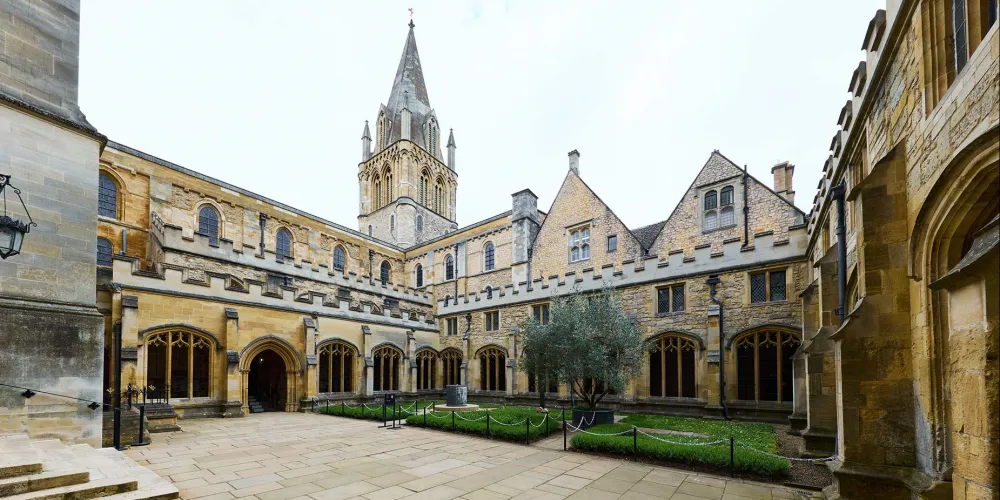
Cloister
Cloisters were a common feature of monastic establishments, as they provided a sheltered space for monks to move about the priory undisturbed by the outside world. The present cloisters were rebuilt in 1499. From the Cloister garden you can look up catch one of the best views of the Cathedral spire. It is the oldest surviving stone spire in England and has been a feature of the skyline since 1230.
The Chapter House was originally built as a meeting place for the monks of the priory – the circular shape of these rooms provided the proper acoustics to allow everyone to be heard. It is one of the oldest parts of the college; the current interior was constructed between 1220 and 1240 but masks an even older building, of which the doorway is the most obvious remaining element.

